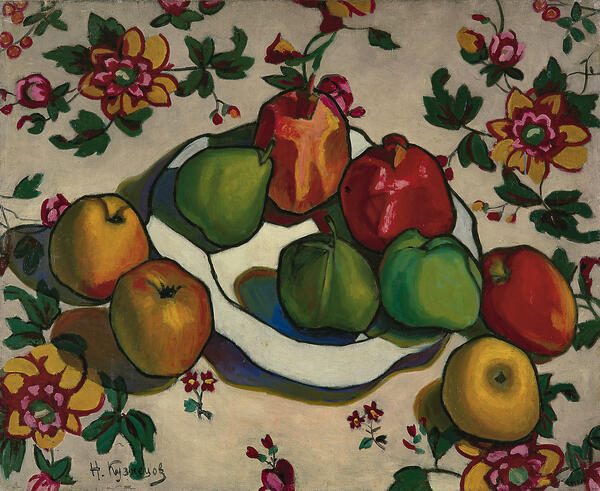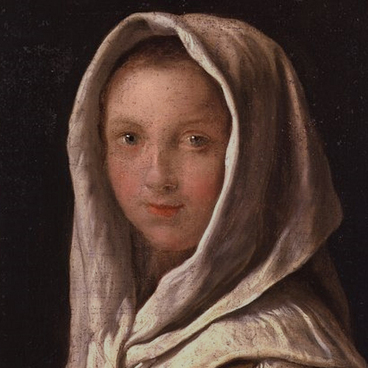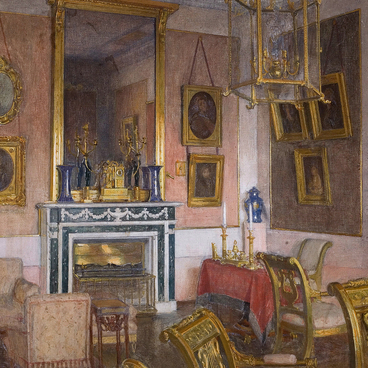Nikolay Kuznetsov was born in 1876 in Moscow. He was interested in drawing as just a child taking lessons from private teachers, and later, while studying at the law institute, he began to visit the workshops of Konstantin Korovin and Valentin Serov. In his memoirs, the artist wrote about Korovin:
#1
Nikolay Kuznetsov
Pomegranates
#2
#4
It was he who “trained” my eyes, and I saw that everything was much more interesting and beautiful than I had seen before. I learned to see and paint with an open mind.
#5
Since 1906, Kuznetsov participated in exhibitions of the Moscow branch of the Association of Artists. In 1907, following the advice of Korovin, he left for Europe. In Europe, Kuznetsov spent three years studying with Charles Guerin, in the studio with Henri Matisse. He returned to his homeland in 1910.
After the Bolshevik revolution, since 1918, Nikolay Kuznetsov worked in the management of urban architecture: he decorated the districts of Moscow for important holidays. In the same time, he created the Proletarian Museum of the Presnensky District, opened his own workshop on Spiridonovka Street, headed an art workshop in the Pushkin Museum. In the late 1930s, he taught at the Stroganov School.
Nikolay Kuznetsov organized his first personal exhibition in 1963. It took place in the House of Artists on Zholtovskogo Street (now Ermolayevsky Lane).
The paintings of Nikolay Kuznetsov are now housed in the State Tretyakov Gallery, the Vladimir-Suzdal Museum Reserve, the Krasnoyarsk State Art Museum named after V. I. Surikov, the Nizhny Novgorod State Art Museum and other large collections.
The artist’s paintings were characterized by the emphasized materialization of depicted objects and the richness of colors. In the paintings of Kuznetsov, the influence of Cezanne was noticeable, for example, in still lifes he deliberately violated the laws of perspective by distorting forms: fruits and dishes seemed to be shown simultaneously from several angles.
In the still life ‘Pomegranates and Apples’ from the museum’s collection, the artist painted fruits lying on the table. The space of a still life has a shallow depth, flatness and conventionality adds a background to it. The fruits, on the contrary, have a sculptural volume as they look sculpted and embossed. Their bright and colored spots alternate and resemble the patterns on the tablecloth. Moreover, the irregular edges of the dish are consonant with the rough shapes of the fruit.
After the Bolshevik revolution, since 1918, Nikolay Kuznetsov worked in the management of urban architecture: he decorated the districts of Moscow for important holidays. In the same time, he created the Proletarian Museum of the Presnensky District, opened his own workshop on Spiridonovka Street, headed an art workshop in the Pushkin Museum. In the late 1930s, he taught at the Stroganov School.
Nikolay Kuznetsov organized his first personal exhibition in 1963. It took place in the House of Artists on Zholtovskogo Street (now Ermolayevsky Lane).
The paintings of Nikolay Kuznetsov are now housed in the State Tretyakov Gallery, the Vladimir-Suzdal Museum Reserve, the Krasnoyarsk State Art Museum named after V. I. Surikov, the Nizhny Novgorod State Art Museum and other large collections.
The artist’s paintings were characterized by the emphasized materialization of depicted objects and the richness of colors. In the paintings of Kuznetsov, the influence of Cezanne was noticeable, for example, in still lifes he deliberately violated the laws of perspective by distorting forms: fruits and dishes seemed to be shown simultaneously from several angles.
In the still life ‘Pomegranates and Apples’ from the museum’s collection, the artist painted fruits lying on the table. The space of a still life has a shallow depth, flatness and conventionality adds a background to it. The fruits, on the contrary, have a sculptural volume as they look sculpted and embossed. Their bright and colored spots alternate and resemble the patterns on the tablecloth. Moreover, the irregular edges of the dish are consonant with the rough shapes of the fruit.
#3
Ministry of Culture of the Russian Federation
читать дальшескрыть
00:00
00:00
1x
Pomegranates
Время создания
1916
Размер
59x63 cm
Техника
oil, canvas
0
Открыть в приложении
Поделиться




